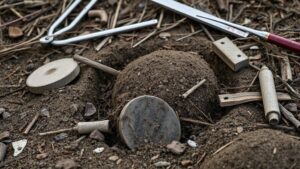Unearthing Silver Relics in Early Mining Towns and Camps
Unearthing Silver Relics in Early Mining Towns and Camps
Exploring the remnants of early mining towns and camps provides a rich narrative of industrial growth, struggle, and the quest for wealth. Silver played a crucial role in shaping these communities, particularly during the 19th century, as prospectors flocked to areas where the mineral was abundant. This article delves into the historical significance, archaeological methodologies, prominent locations, and the cultural impact of discovering silver relics in these erstwhile boomtowns.
The Historical Significance of Silver Mining
Silver mining significantly influenced economic and social landscapes in various parts of the world, especially in the United States. discovery of silver in places like Nevadas Comstock Lode in 1859 catalyzed a massive influx of settlers, resulting in the rapid development of towns such as Virginia City and Gold Hill. According to the U.S. Geological Survey, silver production in the U.S. increased drastically from 1.5 million ounces in 1859 to over 30 million ounces by 1875, highlighting the metals pivotal role in the nation’s economy.
Archaeological Methodologies for Unearthing Relics
The archaeological investigation of early mining towns involves a combination of surveys, excavation, and various analytical techniques. Researchers employ remote sensing technologies such as Ground Penetrating Radar (GPR) to identify subsurface structures before excavation begins. This non-invasive technique allows archaeologists to accurately map out potential areas of interest without disturbing the site.
Excavation efforts typically focus on areas around old mines, processing sites, and living quarters. Artifacts unearthed may include mining tools, silver-bearing ores, and personal belongings of miners which provide insights into their daily lives and socioeconomic conditions.
Prominent Locations of Silver Relics
Several sites across the United States are notable for their rich deposits of silver and the relics that remain. Some key locations include:
- The Comstock Lode: Located in Nevada, it was one of the first major discoveries of silver ore in the United States, leading to Nevadas statehood.
- Leadville: Found in Colorado, this mining town became one of the richest silver districts in the U.S., producing large quantities of silver until the early 20th century.
- Silver City: Established in Idaho, the town was named after the nearby silver deposits and became a bustling community during the mining boom.
Case Studies of Silver Relic Discoveries
One of the most compelling case studies is the excavation at the former mining town of Virginia City, Nevada. Here, archaeologists have successfully recovered thousands of artifacts including mining tools and personal items, which reveal the stories of the workers who lived there. A 2018 study conducted by researchers from the University of Nevada, Reno, uncovered a substantial amount of silver ore remnants, leading to new insights about mining techniques used during the period.
Another important examination took place in Leadville, Colorado, where a 2016 excavation initiative focused on a long-abandoned smelting facility. The findings not only included remnants of silver processing but also highlighted health hazards faced by miners, as over half of the artifacts recovered exhibited high levels of lead contamination.
Cultural Impact and Modern Significance
The legacy of silver mining extends beyond economic gain; it has also shaped local cultures and identities. Mining towns often served as melting pots where diverse groups of immigrants congregated, resulting in a rich tapestry of customs, languages, and traditions. Festivals celebrating the heritage of these communities continue today, emphasizing the importance of mining history both locally and nationally.
Also, the modern relevance of these findings can be seen in legal and environmental contexts. Discovering the impact of mining on local ecosystems paves the way for restoration efforts and informs policy regarding current mining practices.
Conclusion and Actionable Takeaways
Unearthing silver relics in early mining towns not only contributes to our understanding of historical economics but also tells the stories of the individuals who shaped these booming communities. Through careful archaeological practices and the analysis of silver deposits, researchers continue to uncover vital narratives of resilience and adaptation in the face of industrialization.
For those interested in engaging with this fascinating history, opportunities abound through volunteering with archaeological digs or participating in local historical societies. Engaging with these initiatives doesnt just preserve the past; it ensures that the stories of our shared heritage are not forgotten.


